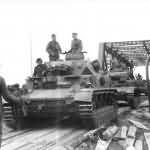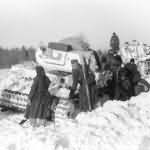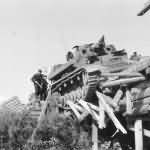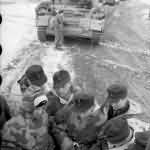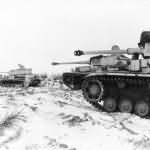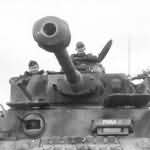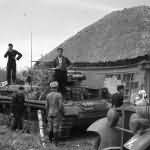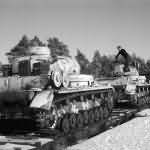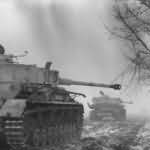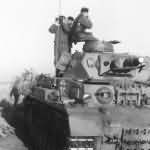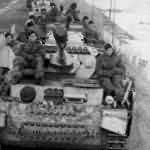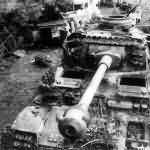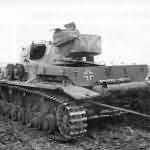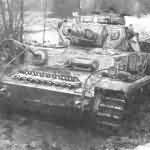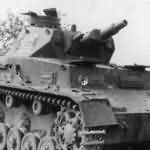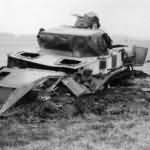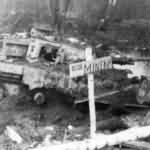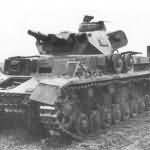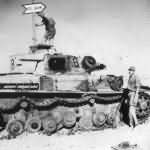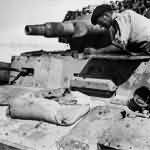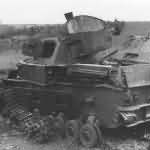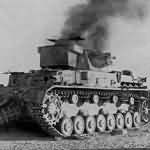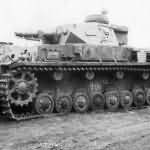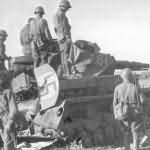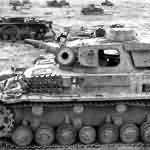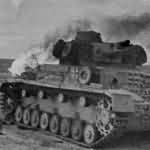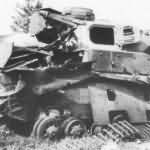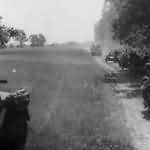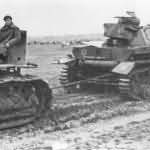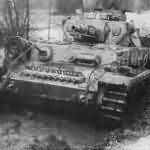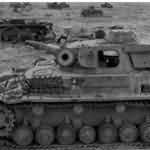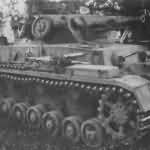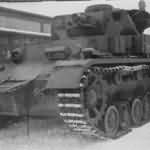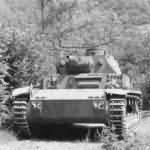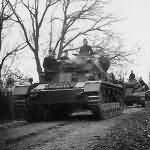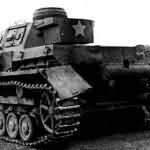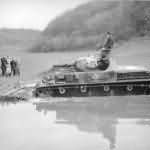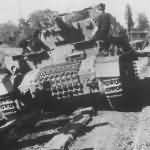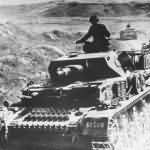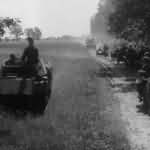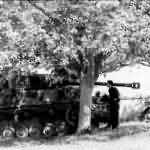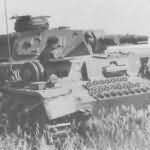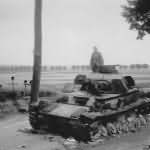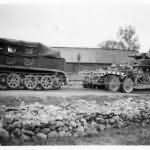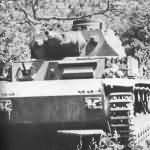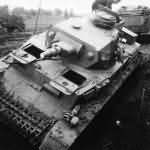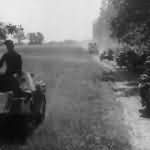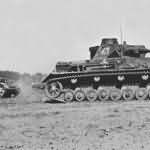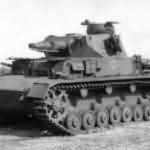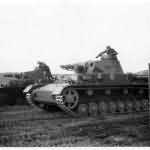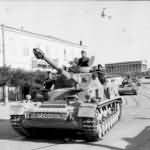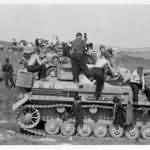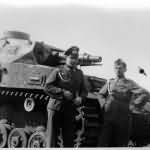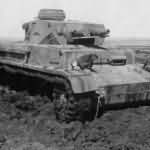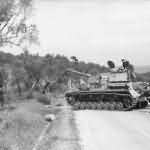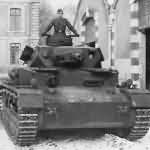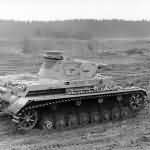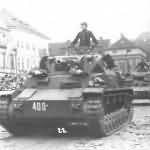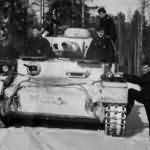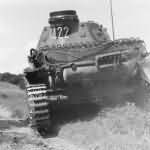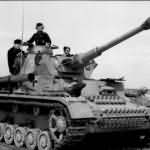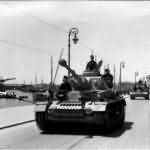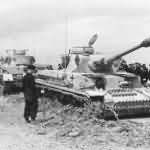Panzer IV Ausf H tank, Romania Eastern Front 1944
Destroyed by internal explosion Panzer IV
Pz.Kpfw.IV tanks and German Infantry winter eastern front
Tanks and German Infantry eastern front
Damaged Pz.Kpfw. IV and crew eastern front
Panzer IV tank wrecked 625
Panzer IV Ausf G tanks Sardinia Palau Marina
Pz.Kpfw.IV Ausf F1 tanks of the Panzergrenadier Division Grossdeutschland, Russia 1942
Panzer IV Ausf H winter camo Eastern Front 3
Russia Panzersoldaten and Panzer IV ausf F1 tank
Panzer IV Ausf. F, winter camo, eastern front 1941
Panzer IV ausf F1 of the 5th Panzer Division (Wehrmacht), Eastern Front
destroyed Pz.Kpfw.IV tanks Western Front
Panzer IV Ausf. F2 tanks eastern front
Panzer IV Ausf F2 tanks number 431 and 424, 14 Panzer Division eastern front
Pz.Kpfw.IV Ausf.D of the 7th Panzer Division near Lepel Eastern Front
Panzer IV Ausf. F1 Eastern Front
Panzer IV Ausf H tanks Eastern front
Blown up Panzer IV lang
Panzer IV Ausf H number 312 with Schürzen and Infantry. Eastern front 1944.
Panzer IV Ausf H with Winterketten and winter camo Eastern Front
Panzer IV Ausf H tank with Schürzen Eastern Front, 1944
Damaged Panzer IV Ausf G Kharkov
Panzer IV ausf G and Schützenpanzerwagen Sd.Kfz. 251 Ausf C , June 1943 eastern front
Panzer IV tanks Sardinia Palau Marina
Panzer IV Ausf H tank with zimmerit winter camo 1251
Panzer IV Ausf H tanks eastern front winter
Panzer IV Audf H with winter camo
Panzer IV Ausf H tactical number 1223 winter camo, Eastern Front
Panzer IV ausf G number 921 of 3rd SS Panzergrenadier Division Totenkopf, Kursk July 1943
Panzer IV Ausf H “Paula” with zimmerit, Western Front 1944
Panzer IV Ausf F1 color photo, eastern front
Destroyed Panzer IV Ausf J, Eastern Front
Panzer IV Ausf. F1 tank of the 31st Panzer Regiment, 5th Panzer Division, Russia 1942
Panzer IV Ausf E, camouflaged in white, rail transport
Panzer IV Ausf H number 1251 with zimmerit, eastern front
Panzer IV Ausf G number 242 eastern front 1942-1943
Russia Panzer IV tanks
Crew atop a white washed Panzer IV Ausf H
Panzer IV ausf C tank, destroyed
Panzer IV ausf F1 tank Russia
Villers Bocage destroyed Panzer IV (6/Panzer-Lehr-Regiment 130) and Panzer VI Tiger #112 of the schwere SS-Panzerabteilung 101
Column of Panzer IV Ausf H tanks, Eastern Front 2
Panzer IV winter, Eastern Front 1944
Russia Panzer IV Ausf G in field
Panzer IV Ausf H coded 1251 with zimmerit, winter camouflage
Panzer IV Ausf F and Panzer II tanks, Russia October 1941
Villers Bocage Panzer IV tank, coded 634 of the 6/Panzer-Lehr-Regiment 130, 1944
Panzer IV tank, Langrohr version with zimmerit
PzKpfw IV Ausf G Langrohr version
knocked out early Panzer IV
Destroyed Panzer IV Ausf. H France 1944
Knocked out Panzer IV Ausf H, Western Front 1944 (zimmerit)
knocked out Panzer IV number 226
knocked out Panzer IV tank 5
knocked out Panzer II
burned out Panzer IV ausf B tank
Panzer IV ausf D tank, destroyed
Panzer IV turret destroyed
Destroyed Panzer IV Ausf B
Panzer IV ausf C tank destroyed, France 1940
knocked out Panzer IV ausf B tank of the 1st Panzer Division (Wehrmacht)
German Panzer IV rear view, France 1940
German Panzer IV ausf D tank
Panzer IV tank
Panzer IV tank
Panzer IV ausf B tank
Panzer IV Ausf B tank destroyed by a internal explosion
Panzer IV tank in mud
Panzer IV ausf E tank, Eastern front
TauchPanzer IV ausf D tank 42
knocked out Panzer IV tank 48
Afrika Korps Panzer IV ausf E tank, coded 8
Panzer IV ausf E with Zusatzpanzer of the Afrika Korps
Panzer IV of the Afrika Korps, rear view
knocked out Panzer IV destroyed by a internal explosion
Panzer IV, M4 Sherman and Jagdpanzer IV
knocked out Panzer IV Ausf D, North Africa
Panzer IV Ausf. E
Panzer IV 61
Panzer IV 8
Panzer IV ausf E tank 56
knocked out Panzer IV tank 46
Panzer IV tank wreckage 58
Panzer IV 41
Panzer IV tank wreckage, North Africa
Panzer IV tank eastern front
Panzer IV ausf F1 tank, winter camouflage
Panzer IV 38
Italy German tanks in field 2
Panzer IV ausf E tank
Panzer IV ausf F 1 tank
Panzer IV ausf F1 tank
knocked out Panzer IV tank, number 539
Panzer IV Ausf D France 1940
Panzer IV Ausf. F1
Panzer IV Ausf D tanks
Captured soviet Panzer IV tank, rear view
Panzer IV ausf B tank
Panzer IV ausf D tank
Panzer IV ausf A tank undergoing field trials
Panzer IV Ausf H tank with zimmerit, number 635. 12th SS Panzer Division Hitlerjugend.
Panzer IV Ausf. E from 7. Panzer-Division
Panzer IV tanks on street 1944
Panzer IV Ausf. G tanks
Panzer IV ausf E tank of the 11th Panzer Division (Wehrmacht), number 11, Yugoslavia 1941
Front view of a heavily camouflaged Panzer IV in France
Panzersoldat and Panzer IV Ausf. C, France
Early Panzer IV tank, Italy
Panzer IV ausf F1 tank, eastern front
Panzer IV Ausf H number 813 Italy
Panzer IV Ausf H number 615, Western Front 1944
Panzer IV ausf F1 tank 82508
Greece Panzer IV Ausf G tank in Harbour
German Panzer IV tank
Panzer IV ausf E “4” rear view
Panzer IV Ausf H tank number 923
Panzer IV ausf E tank
German tanks in field
Panzer IVs column advancing to combat zone, Eastern Front 2
Panzer IV tank on bridge
Panzer IV 40
Panzer IV Ausf H 711
Panzer IV crew hiding under tree
Panzer IV Ausf E with 30 mm thick Zusatzpanzer
Panzer IV ausf D tank of the 10 Panzer Division, France 1940
Wreckage of a German Panzer IV Ausf. C, France 1940
Panzer IV tank
Knocked Out Panzer IV Ausf J, Western Front 1944/45
Sd.Kfz. 8 and Panzer IV on trailer
Panzer IV Ausf D tank
Panzer IV Ausf E tank 31
Panzer IV 39
Panzer IV Ausf B tanks 421 + 422
Panzer IV Ausf H tank in action, Monte Cassino Italy 1944
Panzer IV Ausf H 618 tank Western Front
Italy Panzer IV tank in Panzerwerkstatt
Panzer IV Ausf. E number 613
Panzer IV Ausf H tank Italy
Panzer IV Ausf D
Athens Panzer IV
Panzer IV Ausf H of 12th SS Panzer Division Hitlerjugend, number 625 Western Front 1944
Panzer IV Ausf E tank of the 20th Panzer Division (Wehrmacht) in color
Athens Panzer IV Ausf G tanks, 1943
Italy Panzer IV 4
Panzer IV tanks of the 12. SS-Panzer-Division „Hitlerjugend“, France 1944
Panzer IV Ausf. E during field exercises 22
Panzer IV Ausf F 833 of the 14. Panzer Division (Wehrmacht) in Stalingrad, 1942
Pz.Kpfw. IV Ausf G tank
Panzer IV Ausf. C
Panzer IV Ausf H with schurzen
Panzer IV Ausf F1 during the Russian “Rasputitsa” muddy season
Italy Panzer IV Ausf H tank
Wreckage of a German Panzer IV Ausf F
Pz.Kpfw. IV Ausf. F1 tank front view
Panzer IV ausf D during field exercises 1940
Panzer IV Ausf H Poland 1944, Eastern Front
Panzer IV Ausf. D tank of the Afrika Korps
Panzer IV Ausf. G
Panzer IV Ausf F in France rear view
Panzer IV Ausf B tank number 400, during parade in 1939
Italy Panzer IV Ausf H tanks
Panzer IV Ausf. H of 2nd Panzer Division (Wehrmacht), number 825 France 1944
Crew on top of their Panzer IV tank, France 1944
Greece, Panzer IV Ausf C tank and British POW
Panzer IV Ausf F1 tank and crew winter camouflage
Afrika Korps Panzer IV damaged turret
Brand new Panzer IV Ausf F at Krupp-Grusonwerk plant
Abandoned Panzer IV ausf E tank of the Deutsches Afrikakorps (DAK)
German Panzer IV Ausf. D with Zusatzpanzer, frontal view
Panzer IV tank number 422, rear view France 1940
burning Panzer IV tank
Panzer IV Ausf G number 713 of 1st Panzer Division (Wehrmacht), Greece 1943
Panzer IV ausf C tank of the 65 Panzer Regiment, rail transport
Panzer IV tank number 301
Greece Panzer IV Ausf G tanks in Harbour
Panzer IV tanks of 1st Panzer Division (Wehrmacht)
History
The Panzerkampfwagen IV (short PzKpfw IV or Panzer IV) was a medium German tank of the Second World War. Initially produced only in very small numbers. Panzer IV, developed by Krupp and produced from 1937 until the end of the war, was the most-built German tank with 8500 copies. The tank, originally equipped with a short gun, was originally designed as a support vehicle, but its range of operations changed fundamentally with the installation of a long gun. Although he did not reach the popularity level of a Panther or Tiger because of the reception in military literature, he was the most important German tank in the second half of the war. The Panzerkampfwagen IV was used in almost all fronts. In addition, the chassis served as a basis for many other vehicles.
In early 1930’, a working group around the later Generaloberst Heinz Guderian had provided for the final equipment of the future Panzertruppe two basic types of tanks, Heereswaffenamt setting the final equipment of the Panzer divisions in January 1934. Three of the four companies of an armored division were to receive a tank with a AT gun, the later Panzer III. The fourth company was to be equipped with a support vehicle that was to fight targets with its large-caliber weapon for which the smaller Panzer III AT weapon was unsuitable. From this consideration the Panzerkampfwagen IV was built.
Requirement profile was similar to that of Panzer III. The crew should consist of five men, a radio should be able to communicate, and the total weight 24 tonnes.
Because of the Treaty of Versailles still valid the vehicle was given the camouflage designation “Mittlerer Traktor” for reasons of secrecy. This nickname was changed shortly afterwards in “Begleitwagen” (BW). Rheinmetall, MAN and Krupp took part in the development work that began in late 1934. New was the concept of a support tank with only one turret, because at that time, the armies of the other countries felt that for such tasks, multi-turret tank were better suited.
The Rheinmetall prototype had a weight of 18 tons and reached a top speed of 30 km / h with a 320 hp engine. The prototype of MAN had a six-wheeled Schachtellaufwerk interleaved-roadwheel suspension, which was influenced by Erich Kniepkamp, who later became the main responsible for the introduction of the Schachtellaufwerk in the German tanks as head of department in the Heereswaffenamt. At the instigation of the HWA, the Krupp proposal also provided for such a drive with torsion bar. Although this drive was less sensitive to shocks and had better running characteristics, the Krupp engineers insisted on their leaf springing and took back the torsion bar despite the resistance of the HWA. Krupp instead equipped it with a simple leaf spring double-bogie suspension, with eight rubber-rimmed roadwheels per side. After 1935/36 all prototypes at the test center in Kummersdorf had passed through extensive tests, Krupp was determined as a final production company. The Panzer IV was the last German armored car still developed in peace.
In October 1937 the production of the “A” version of the Panzer IV was carried out at the Krupp-Grusonwerk in Magdeburg-Buckau. In contrast to the production of the previous Panzerkampfwagen I to III, in which several manufacturers were consulted, the Magdeburger Werk was the only production facility for the Panzer IV until the autumn of 1941. Due to its function as a support vehicle, its procurement was much smaller than that of the tank III, which was noticeable in the initially low number of pieces.
After the equipment of the Panzer Regiments, production remained at a low level even after the beginning of the war. The production of Panzer IV did not yet have a special priority, which also affected Krupp as a manufacturer. Thus in the beginning of 1940 about 1,200 workers were working in the Magdeburg factory, the production of Panzer IV occupying only 35% of the order volume.
In the autumn of 1941, production was extended to Vogtländische Maschinenfabrik VOMAG, Plauen and the Nibelungenwerke in St. Valentin. The main works of Krupp in Essen, Eisen- und Hüttenwerke in Bochum, the Eisenwerke Oberdonau in Linz, Dortmund-Hörder Hüttenverein in Dortmund and Böhler & Co. in Kapfenberg served as major suppliers of armouring plates, hulls and turrets. The Maybach engines came mainly from the Maybach parent plant and the subsidiary Nordbau as well as licensed from Orenstein & Koppel in Nordhausen and MAN. The transmissions came from ZF in Friedrichshafen. Final assembly of a Panzer IV took around 2000 working hours. The total production time including all parts of the subcontractors was estimated to be around 15000 hours. Price of a tank amounted to just over 100000 RM without a main armament.
Like all German tanks, the Panzer IV was manufactured in high-quality work, especially at the beginning of production, which was naturally counterbalanced by a rational mass production. Although the proportion of manganese, chromium and molybdenum in the armour steadily declined during the course of production as a result of material deficiencies and therefore also its quality, the special surface treatment achieved a good impact strength. A Brinell hardness test on the British side showed the high value of up to 520 Brinell for the front armor of a Ausf G, which was the highest degree of hardness of all German tanks.
Variants
Ausführung A
The first series of the Panzerkampfwagen IV was launched under the type designation 1./BW in October 1937. Up to the June of the following year, 35 of the Ausf. A were produced. The armament consisted of a short gun 75 mm KwK 37 with caliber length L/24 (barrel length = 1800 mm) and two MG 34. One coaxial MG 34 machine gun was mounted to the right of the main gun, second was built into the radio-operator’s front plate. Commander’s cupola was adopted from the Pzkpfw III Ausf. B. Vehicle had a combat weight of 17.3 tons and was powered with the 12-cylinder, 230 hp Maybach HL 108 TR, which was also used in Panzer III and a Zahnradfabrik SFG 75 five-speed transmission. The vehicles served in Norway, Poland, and France. Surviving Ausf As were used for training purposes.
Ausführung B
Second series was launched under the type designation 2/BW in May 1938. By reinforcing the tank front armor to 30 mm, the weight rose to 17.7 tons. The powerful Maybach HL 120 TR engine with 285 hp with a new six-speed SSG 76 transmission was used as the drive unit. The front MG, which was operated by the radio operator, was omitted, but instead a flap for his machine gun was available to him. The changed visor opening for the driver could now be protected with two overlapping slides (Fahrersehklappe 30). Ammunition stowage were reduced to save weight. Turret retained the same armour and armament configuration as the earlier Ausf A but commander’s cupola was adopted from the Panzer III Ausf. C.
The Pzkpfw IV Ausf B had a production run of 42 units.
Ausführung C
The 134 vehicles of the Ausf.C (3/BW) was hardly differed from the predecessor model. The overall weight increased slightly by a stronger front armor of the turret. In addition, the coaxial MG was now protected with a coat of armor. Late Ausf C were equipped with a wishboneshaped antenna deflector mounted under the main gun and Maybach HL 120 TRM engine.
Ausführung D
Major changes were made in the 248 Panzerkampfwagen of Ausf. D built in two series (4 and 5/BW) in 1938/39. The front wall was now no longer straight, but rather stepped back in front of the radio operator. This crew member now also had a MG available in a ball mount.. The rear and side armor of the hull was reinforced from 15 to 20 mm. A 35 mm thick external gun mantlet to the KwK 37 L/24 was introduced.
Late tanks were equipped with additional armor, welded or bolted. 30 mm to the front and 20 mm on side hull superstructure. From October 1939 to October 1940 232 Ausf.D tanks were completed. Some Ausf Ds were fitted with the 7,5 cm Kw.K.40 L/48 guns and used for training purposes. Also some tanks were converted to “tropical” variant in the assembly plant by installing hatches with ventilation slits and increasing fan speed.
Ausführung E
In 1940 the production 200 of Ausf. E (6/BW) started. To reinforce the insufficient armor, additional plates were attached to the bow (30 mm) and sides of the hull (20 mm).
The rear turret plate was redesigned to cover the previous bulge under the cupola. As a result, from this version onwards, a stowage box could be attached to the tower as a standard feature. Brake access hatches were now flush mounted on the front glacis plate and right side turret signal port was deleted. Some tanks were converted to “tropical” variant in the assembly plant in 1941. Some “refurbished” Ausf Es were fitted with the 7,5 cm Kw.K.40 guns.
Ausführung F
The experiences of the previous campaigns were reflected in the Audf F (7/BW) delivered from April 1941. Frontal armor of the hull, superstructure, and turret was made from a 50 mm plates. Sides were made from a 30 mm plates. The front superstructure was now a straight again.
Need for more firepower to combat Soviet tanks resulted in the fitting of the K.w.K 40 L/43 75 mm gun to the PzKpfw IV Ausf. F. KwK 40 was equipped with a single baffle muzzle brake.
With this “Langrohrkanone”, the role of the Panzer IV finally changed from the support to the combat tank, whose most important task now was the fight against enemy tanks.
Although the new ammunition was larger, 87 floors could now be carried by improved storage instead of 80.
To distinguish, the models with the short gun were designated as Ausf F1 and those with the long gun as F2. Initially, the F2 models were designated a “7/BW Umbau” or Pz.Kpfw.IV Ausf.F-Umbau. On June 5, 1942, the Waffenamt ordered the use of the designation 8./BW. On July 1, 1942, the Waffenamt made it clear that all Panzer IVs with a long cannon were to be called 8/BW. In September, the designation Ausf. F2 was officially replaced by Ausf G. After production of 462 F1 models, a total of 200 F2 models were delivered from March to July 1942.
Ausführung G
From March 1942 to June 1943 about 1700 Ausf G left the factory. A double-baffle muzzle brake replaced the previously used spherical muzzle brake. The experience with the extreme climatic conditions of the Russian winter led to the installation of a cooling water exchanger, with which it was possible to pump hot cooling water into the cooling circuit of another vehicle in order to be able to counter the cold start difficulties that had so far often occurred.
From the spring of 1943 onwards the final version of the 7,5 cm KwK 40 L/48 made by Rheinmetall was available with its longer barrel length of 48 caliber lengths and was installed from April 1943 onwards in “G”. From this point onwards, this gun became the standard weapon of Panzer IV. L/48 had a higher muzzle velocity, improved ballistics, and better penetrating power. All vehicles with a short 75 mm gun, which were supplied with the homeland service, were also upgraded to this weapon.
Other changes were introduced during the production: two vision slots on the turret sides were deleted, rack for two roadwheels on the left fender and brackets for seven track links on the glacis plate, new commander’s cupola with single-piece hatch, Schuerzen for protection against anti-tank rifles.
In the summer of 1942, an arrangement was made to reinforce the front armor of the hull to 80 mm, despite the possible disadvantages in off-road operation, which was achieved by attaching 30 mm thick plates. The production numbers of such upgraded Panzer IV steadily increased, and all Panzer IV with reinforced armor were produced from January 1943.
Ausführung H
In April 1943 Ausf H version (9/BW) began to be delivered. The long KwK 40 L/48 was fitted as standard and the front armor of the tank was now 80 mm. Due to lack of material, the rubber-coated return rollers were partially replaced by steel return rollers. The vehicles were delivered as standard with side Schurzen. It was about 5 mm thick plates which were removable on the hull and fixed to the turret and protected from AT rifles (a certain protection effect was also observed with hollow charge and bazookas).
Ausf H also had anti-magnetic paste zimmerit, deleted the visors on the superstructure sides, reinforced final drive with higher gear ratios reducing the maximum speed to 38 km/h and turret roof armor was increased to 15 mm
Ausführung J
In February 1944 the last series of the Panzerkampfwagen IV appeared with the Ausf J (10./BW). The priority was a production simplification. As a tactical disadvantage was the elimination of the electrical turret drive, whereby the turret now had to be turned by hand. Instead, an additional 200 l fuel tank was installed to extend the range. The side aprons made from wire mesh screens (Thoma Schurzen), but this did not limit their effect. The turret roof was up-armored to 16 mm. By September 1944, Zimmerit was no longer being applied to Ausf J. Instead of four return rollers, the chassis had only three more from December 1944. The large external exhaust tailpipe was replaced in September 1944 by two simple upwards directed pipes. This model was initially produced by VOMAG, later only by the Nibelungswerke – actually up to the end of the war.
Bibliography and sources
- Kevin Hjermstad: Panzer IV. The Panzerkampfwagen IV Medium Tank 1939-1945, Squadron Signal 6081
- Thomas L. Jentz, Louis Doyle: Panzerkampfwagen IV: Grosstraktor to Panzerbefehlswagen IV, Panzer Tracts No.4
- Hilary Doyle, Lucas Friedli and Thomas L. Jentz: Panzer Tracts No.4-3 Panzerkampfwagen IV Ausf. H/Ausf. J, 1943 to 1945
- Krzysztof Mucha: Sd.Kfz.161 Panzer IV Ausf.J, Kagero TopDrawings 8 (Polish/English)
- Krzysztof Mucha, George Parada, Wojciech Styrna: Panzer IV Sd.Kfz.161 Vol.I, Kagero Photosniper 16
- Krzysztof Mucha: Sd.Kfz. 161 Panzer IV Ausf. H/J, Kagero TopDrawings 25
- Walter J. Spielberger: Panzer IV & its Variants – The Spielberger German Armor & Military Vehicles Vol.IV
- Panzer IV Panzerkampfwagen IV (Pz.Kpfw.IV. Sd.Kfz.161), History File №003
- Paul Thomas: Panzer IV at War 1939-1945, Images of War
- Louis Doyle & Tom Jentz: Panzerkampfwagen IV Ausf.G, H and J 1942-45, Osprey New Vanguard 39
- Steven J. Zaloga: Panzer IV vs Sherman: France 1944, Osprey Duel 70
- Steven J. Zaloga: Panzer IV vs Char B1 BIS: France 1940, Osprey Duel 33
- Steven J. Zaloga: Panzer in the Gunsights 2 – German AFVs and Artillery in the ETO 1944-45 in US Army Photos
- Bob Carruthers: Panzer IV. The Workhorse of the Panzerwaffe, Hitler’s War Machine
- Horst Scheibert: Die Panzer IV – Familie, Waffen-Arsenal Band 104 (german)
- Bruce Culver: PzKpfw IV in action, Squadron Signal 2012
- Norbert Számvéber: Waffen-SS Armour in Normandy: The Combat History of SS Panzer Regiment 12 and SS Panzerjäger Abteilung 12, Normandy 1944, based on their original war diaries
- Bruno Friesen: Panzer Gunner. From My Native Canada to the German Ostfront and Back. In Action with 25th Panzer Regiment, 7th Panzer Division 1944-45
- Jon Feenstra: Achtung Panzer Tank – The German Invasion of France & the Low Countries, Concord Armor at War 7041
- Tom Cockle: Panzerkampfwagen III and IV 1939-45, Concord
- Janusz Ledwoch: PzKpfw IV Vol.I, II, Wydawnictwo Militaria 141, 147 (Polish/English)
- Janusz Ledwoch: PzKpfw IV Colour, Wydawnictwo Militaria 319
- Carlos Caballero Jurado, Lucas Molina Franco: Panzer IV: The Wehrmacht’s armored fist
- Jonathan Forty: Pzkpfw Ausf A to J, Tanks in Detail
- Horst Riebenstahl & Horst Scheibert: Panzer IV (Lang), Schiffer Military History
- Wojciech Gawrych: PzKpfw IV Ausf. G, Armor PhotoGallery 22
- C. Ellis: TauchPzKpfw IV Ausf D&E. A pictorial study of German submersible tanks, their units and markings







